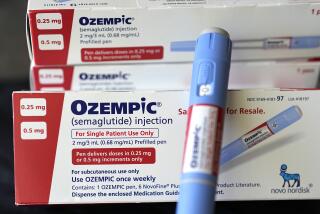Companies spent nearly $30 billion in one year marketing medical products to Americans
Drug makers and other healthcare companies spent almost $30 billion in a single year to influence the medical choices made by Americans and steer them toward treatments that were newer, vastly more expensive and sometimes riskier than their tried-and-true alternatives, new research shows.
The 2016 expenditures paid for TV commercials, sponsorships of patients’ groups, promotional meetings for doctors, free drug samples and perks for prescribers, the study says. The amount represents a 70% increase since 1997, when drug companies began making direct appeals to American consumers.
The study, published this week in the Journal of the American Medical Assn., offers the most comprehensive accounting of healthcare marketing efforts to date. It traces broad shifts in the media and regulatory environment in which health companies operate, as well as the drugs and services — including erectile dysfunction pills, DNA testing kits and robotic surgery services — they are keen to sell.
And it makes clear that while lawmakers and regulators have tried to counter the impact of healthcare marketing in recent years, the reforms have had little effect on an industry that accounts for nearly 18% of the country’s gross domestic product.
“What we see here is a remarkable acceleration in spending by drug companies and others to consumers and to physicians and nurses and anyone who has any remote kind of influence on the purchase of prescription drugs,” said Dr. Jerome P. Kassirer, author of “On the Take: How Medicine’s Complicity With Big Business Can Endanger Your Health.” Since the tally is based only on information that’s publicly available, “their results are probably a great underestimation of the actual amount spent on advertising and marketing,” he said.
Kassirer, a former editor of the New England Journal of Medicine, said there’s no doubt in his mind that the profligate spending influences doctors and patients: “These companies would not sink so much money into all this marketing if it didn’t work.”
The study was conducted by Dr. Lisa M. Schwartz and Dr. Steven Woloshin from the Dartmouth Institute for Health Policy and Clinical Practice, a husband-and-wife team that has long warned of the risks that come with excessive medical treatments and diagnoses. (Schwartz died of cancer in November at the age of 55.)
The pair show that makers of brand-name prescription drugs dramatically increased their efforts to have patients ask their doctors about specific products by name. In 1997, when glossy magazine ads and upbeat television commercials first began to appear widely, the total amount spent to influence consumers was $1.3 billion. By 2016, when pitchmen had distilled complex medical choices into jingles, eye-catching graphics and a litany of side effects voiced over images of happy patients in soaring landscapes, the tab reached $6 billion.
That year, a new generation of diabetes drugs topped the listed of most-advertised medications, with $725 million spent to advertise medications like Trulicity, Farxiga and Victoza. New drugs for dermatological conditions, pain, and heart problems followed closely.
In addition to creating such blockbusters as Viagra, the insomnia drug Ambien and a slew of new statins to reduce cholesterol, the drug industry has increasingly turned to a more indirect approach in its marketing: sponsoring disease-awareness campaigns. Such campaigns, in which a company sponsors ads that do not name a particular medication, rose from 44 in 1997 to 401 in 2016, with an attendant spending increase from $177 million to $430 million, the study authors found.
Some campaigns encourage patients to seek treatment for underdiagnosed or stigmatized diseases, such as depression or HIV. Others appear to sweep conditions that weren’t conventionally considered medical problems — including dry eyes and age-related testosterone loss — into the realm of medicine. A previous study found that between 2009 and 2013, while a campaign to raise awareness of “low testosterone of aging” ran, sales of prescription testosterone surged — despite the fact that the Food and Drug Administration never approved the medication for that use. (The FDA raised no objections.)
Schwartz and Woloshin wrote that disease-awareness campaigns often allow companies to bypass some of the regulatory oversight that usually governs drug ads while still driving patients to their branded products.
Consider, Woloshin said in an interview, that the current epidemic of opioid addiction can be traced in part to one such campaign underwritten by the makers of narcotic pain drugs. Asserting without evidence that addiction risk was slight, Oxycontin manufacturer Purdue Pharma helped underwrite a campaign urging doctors to consider pain “the fifth vital sign.”
Indeed, the new study underscores that the medical profession, not the buying public, remains the central focus of these marketing efforts. In 2016, more than two-thirds of all marketing expenditures — $20.3 billion — were spent to promote new drugs to physicians and their medical allies and staffs, whose prescription pads make them key gatekeepers to medical treatments.
Much of that largesse went to the distribution of drug samples by sales representatives, a practice that allows doctors to start patients on new medication with a free first round and cements their brand loyalty early in the prescribing process. In 2016, free samples accounted for $13.5 billion in marketing expenditures, up from $8.9 billion in 1997. Drug companies spent an additional $5 billion to dispatch more than 70,000 sales reps to brief medical professionals about their products, often over a free lunch.
Spending on this marketing practice, called “detailing,” did not change significantly in the study’s 20-year span. Some physicians were surprised that widespread efforts to curb these interactions at medical centers around the country appeared to have little effect.
“It sounds like the industry has found a way to keep its strong links to the medical professionals,” said Dr. David Blumenthal, a longtime Harvard University physician and researcher who is president of the Commonwealth Fund, a philanthropy focusing on health and social policy issues.
The 2010 Sunshine Act required drug companies to disclose payments or gifts to physicians and teaching hospitals. But it did not cover nurses, physician assistants, nutritionists, pharmacists and pharmacy benefits managers, who also have a strong hand in patients’ choice of prescription medications.
Woloshin said “it makes sense to believe” that after the law went into effect, drug companies shifted their focus to these other medical professionals. Starting in 2022, gifts and payments to them must be reported as well.
What’s clear is that detailing medical professionals remains a strong investment. Schwartz and Woloshin cited a 2001 analysis suggesting that every dollar spent results in two dollars in sales. For new drugs, the reward was even richer: $10 in sales for every dollar spent on direct marketing to a medical professional.
In 2016, companies paid physicians and teaching hospitals $979 million for non-research activities. That included $381 million for doctors to make presentations developed by drug and healthcare firms at lunches or dinners, $210 million for consulting services, $164 million for food and beverages, $97 million for travel and lodging, and $15 million for honoraria.
“What’s striking is the sheer volume, and the incredible tentacles” of the healthcare marketing effort, “despite policies trying to eliminate undue influence,” Woloshin said. The result, he said, is a system that drives patients toward more expensive products with a shorter and less complete safety history, when cheaper and more fully vetted medications are available.
Woloshin also bemoaned the limited state of regulatory oversight, “which is a big problem, since companies have an interest in selling their products so you would expect they would overstate their benefits and understate their risks.” Even as marketing efforts have expanded, the FDA issued fewer violation letters to companies engaged in misleading or illegal promotional efforts.
The likely explanation is not that companies are doing a better job of following the rules, Woloshin said. More likely, it’s that the FDA and the Federal Trade Commission, which oversee medical marketing, are “underfunded, understaffed and overwhelmed.”
The new study proposes many changes that could limit doctors’ and patients’ exposure to medical marketing and help consumers evaluate marketing claims more critically. But substantial limits on direct-to-consumer drug advertising have been scuttled on freedom-of-speech grounds.
It’s a reminder, Blumenthal said, that when it comes to commercial intrusion, there is nothing sacred about the doctor-patient relationship in the United States.
“Healthcare is a commercial market like any other,” he said.
The medical profession needs to help patients make the best decisions for their health amid advertising that is “very powerful, very clever and quite effective. But I have major concerns about whether it positively affects Americans’ health.”







